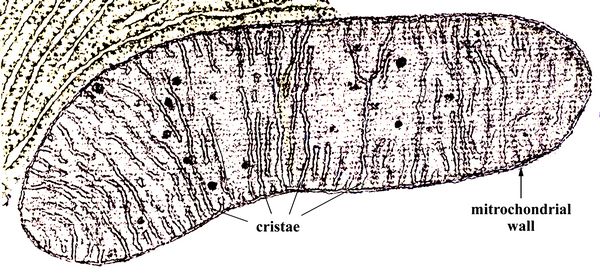Athena Review Image Archive ™
Mitochondrion, showing cristae (SEM)

Scanning electron micrograph (SEM) of mitochondrion (after Margulis & Schwartz).
Mitochondria are organelles in eukaryotic cells,.which provide ATP energy to molecules.
Based on fossil and genetic records, the origins of mitochondrions may have occurred by about 1.8 billion years ago. Mitochondria are filled with ATP-producing membranes called cristae. The mitochondrion organelle acquired its own double-surrounding membrane, of which the innermost also forms the bounded enclosures walled with cristae.
The
mitochondrion also retains its own DNA, providing evidence that
mitochondria were originally separate organisms that were incorportated
in a larger organism in a case of endosymbiosis (Margulis and
Schwartz 1988). Part of the mitochrondial DNA migrated to the main
"captor" cell nucleus, but part of it remained with the mitrochondria
organelle, which could then reproduce independently by cell division
within the host cell.
Mitochondrial DNA provides one of the most
important methods for comparing one organism with another, and
determining when they may have split off from common ancestors. All
eukaroyotes, whether plants, animals, fungi, or protcists like
one-celled algae, have mitochondria, which in bisexual animals descends
only from the maternal side.
Reference:
Margulis, L. and K.V. Schwartz 1988. Five Kingdoms. An Illustrated Guide to the Phylla of Life on Earth. New York, W.H. Freeman (2nd ed.).
Copyright © 1996-2020 Rust Family Foundation (All Rights Reserved).